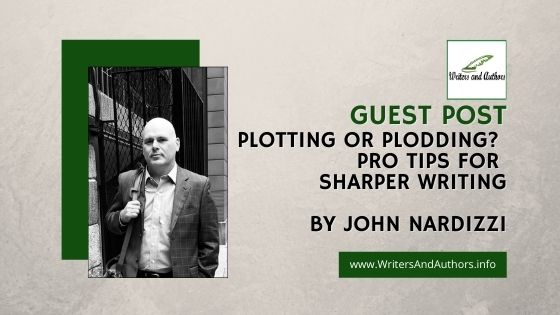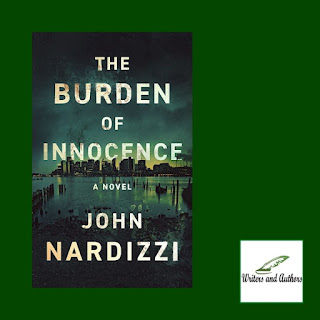Plotting or Plodding?
Pro Tips for Sharper Writing
Guest post by John Nardizzi
We've all heard expert advice from writers and teachers on sharpening our writing. Here are some of the top tips I've learned from fellow writers and editors.
Opening MoodPurchase Links: Amazon | Barnes & Noble |
Goodreads | Kobo | Google Play | iBooks
G. Miki Hayden's primer Writing the Mystery points to the opening of John Grisham's The Firm as a tour de force in setting a sinister tone: “The very start of the book exudes largeness. The new hireling attorney achieves an opulent lifestyle, almost without effort, but something ominous lurks beneath the surface.” The current state of the publishing industry seems to reflect this sentiment, which is unfortunate, given some of the best novels do a slow burn before exploding. Even if you don't leap into external action, the mood and tone of some internal conflict in a character can make your opening sing.
Character Drives the Plot
Readers want to engage with the book emotionally. That means characters crashing together in dramatic and unexpected ways that raise the themes of what it means to be human.
Few books deliver that more powerfully than Delia Owens’ mystery novel When the Crawdads Sing. The narrator Kya is a young girl who comes from a family eking out a living in a marsh near the North Carolina coast, "squeezed together like penned rabbits… in a rough-cut shack, its screened porch staring big-eyed from under the oaks". Her alcoholic father abuses her mother, who one day gathers her life's treasures in an old blue suitcase and walks away in her fake alligator skin shoes. Kya knows something major is happening: “Her throat tight, she whispered, "But Ma's carrying' that blue case like she's goin' somewhere big." The action is simple—a woman walking down a dirt road. But the sense of character Owens created in a few deft strokes rivets you to the page.
A Visual Chapter Layout
My last book, The Burden of Innocence, felt a little unbalanced as I edited a draft. So I took a tip from the writer Tom Davidson, and got a bunch of index cards, one for each chapter. I then wrote a basic 3 to 10 word summation on each index card of what happened in each chapter: “PI meets a witness near the harbor” or “Detective gets attacked in Chelsea”, “Detective eats dinner again with a witness.” Then I laid out the cards in chronological order (in a block) on the floor.
This visual exercise made this clear that I packed too many heavy action scenes in one section. I took photos to record the current layout. I then rearranged the cards a bit to redistribute the action and make the plot evolve more smoothly. And I rearranged them a few more times. Yes, you can do this with just an outline, but laying out every scene like a filmmaker (and we live in the age of video) was more helpful in plotting than anything I had done.
Vary Sentence Length
In the beginning of my career as an investigator, I wrote long sentences, a habit from law school; law review articles and case law tend to favor this style. Not a promising trait for a fiction writer (unless your last name is Faulkner). One of by best editors tore my early drafts to shreds, telling me the writing had potential, but only if I simplified my approach. She pointed out that, as the plot changed, I could use varying sentence length in different ways: to accelerate the reader along in action scenes, or slow them down if the mood was one of careful scheming or a quiet talk. Think of a tense situation in life. How is your sense of sight and sound affected? The way you structure language can heighten or undercut the rhythm of a particular scene.
Poetry Versus Plain Writing
T.S. Eliot once wrote, “Genuine poetry can communicate before it is understood.” He advocated the use of sharp, hard images that bypassed the conscious mind to make the reader feel things, or understand certain instinctive truths.
Contrast that advice with crime fiction Elmore Leonard, who wrote a humorous (yet serious) piece about his rules of writing: “Try to leave out the part that readers tend to skip… If it sounds like writing, I rewrite it.”
Of course, we all strive to write that unforgettable line, to find Eliot image, something that communicates deeply. But know that you're probably going to fail. Eliot's images can be effective, but only if used sparingly; otherwise, the writing appears bloated— “the part that readers tend to skip,” as Leonard says. Finding that balance between working your own unique voice and just getting the darn book done is the constant struggle of writing.
Bio
John Nardizzi is an award-winning writer and investigator. His crime novels have won praise for crackling dialogue and pithy observations of detective work. He speaks and writes about investigations in numerous settings, including World Association of Detectives, Lawyers Weekly, Pursuit Magazine and PI Magazine.
His work on innocence cases led to the exoneration Gary Cifizzari and James Watson (he was awarded the Arc of Justice for the Watson case in 2021), as well as million dollar settlements for clients Dennis Maher and the estate of Kenneth Waters, whose story was featured in the film Conviction. Prior to his PI career, he failed to hold any restaurant job for longer than a week. He lives near Boston, Massachusetts.
Author links:















3 Comments
Great guest post!!!
ReplyDeleteSome really good ideas here. I once jokingly asked one of my favorite authors if she wrote things down on index cards and covered her livingroom floor with them when writing LOL. So, I personally love the index card idea!
For a visual person, the index cards work well. I felt a little like Martin Scorcese.
ReplyDeleteNice Article. Very informative. I learned new information from your article, you are doing a great job.
ReplyDeleteDevOps Training
I love to hear from you. So feel free to comment, but keep in mind the basics of blog etiquette — no spam, no profanity, no slander, etc.
Thanks for being an active part of the Writers and Authors community.